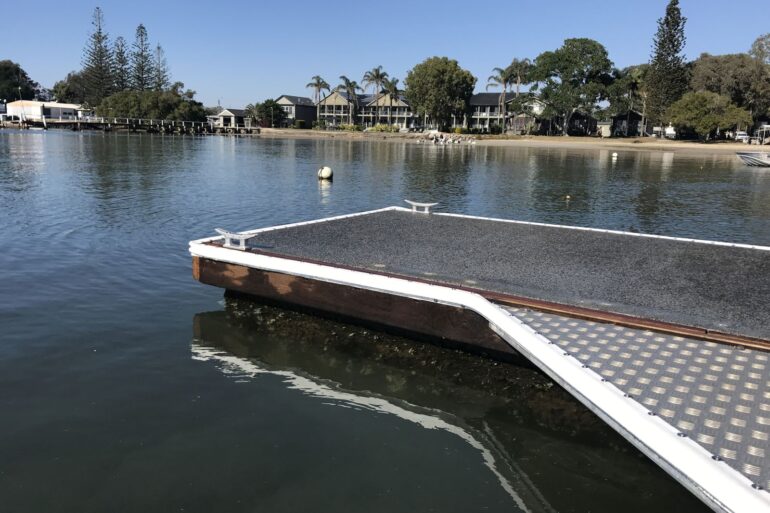
Floating docks are growing in popularity. Not only here on the Gold Coast and on the Sunshine Coast, where we service, but across Australia and the world.
What we call pontoons are actually floating docks – or to clarify, a floating dock is one element of a pontoon. My point is, they’re practically the same thing, so don’t get confused. A pontoon comprises a floating dock, a mooring option, and a gangway, and combined; they offer boat-lovers and waterfront home-owners a modern jetty solution to enjoy waterfront living to the fullest.
At Micks Marine Maintenance, we specialise in all aspects of marine maintenance, including the sale, maintenance and repair of floating docks on the Gold Coast and Sunshine Coast. Therefore, we know all the answers to the most pressing questions.
Continue reading as we answer the most frequently asked questions pertaining to floating docks.
How does a floating dock work?
The floating dock systems that we offer at Micks Marine Maintenance work on the premises that there are three distinctive parts; there is the gangway, the mooring option and the dock. The gangway connects the land to the dock, and the mooring option (strut, cable, or piles), is what keeps everything in place.
Although our floating docks feature concrete docks, the underside features a polystyrene void which is wrapped in HDPE liner. This enables it to float.
How much weight can a floating dock hold?
There is no fixed answer to this question. Calculating the required total buoyancy of a dock depends on the size of the floating dock and the mooring option. Which, of course, must then be adequate for the size of the boat moored. This is a complex calculation that is best left to engineers.
Our engineer bases his calculations on an individual’s needs. Our floating docks exceed the engineering requirements.
How do you hook up a floating dock?
Our floating docks are “hooked up” or connected to shore in one of three ways; they are either connected via a strut arm, cross-over cables, or piles. Strut and Cable connections require a shore-mounted mooring block. A gangway is then needed to make the connection between the land and the dock.
What is a floating dock used for?
A floating dock can be used for a variety of things. Here, on the Gold Coast, and on the Sunshine Coast, they are most commonly used simply to enjoy waterfront living more. Many floating dock owners don’t even have a boat; they merely use it for fishing or to appreciate their waterfront view all the more or to add market value to their property.
For boating enthusiast though, a floating dock is a must! It enables them to moor their boat at home, and head out whenever they like without having to deal with the long and tiresome process of getting to a boat ramp, getting the boat in the water, finding a carpark near the ramp and then getting it out and driving home at the end of the day.
How do you stabilise a floating dock?
I touched on this a little earlier. Other types of floating docks may differ, but pontoon floating docks are stabilised by either a mooring block at the shore that connects to the dock via either stainless steel cables (cable pontoons) or an aluminium strut arm (strut pontoons), or by PVC, concrete or steel piles (piled pontoons).
Conclusion
Floating docks are quickly becoming a must-have feature of any waterfront home on the Gold Coast and Sunshine Coast. Their rise in popularity has piqued the interest of many, of whom, have questions they’d like answered.
Common questions about floating docks include how they work, how much weight can they hold, how are they hooked up, what are they used for, and how are they stabilised.
This article contains the answers to these questions, but if you would like further information simply give us a call. And, if you’re considering having a floating dock installed on the Gold Coast or Sunshine Coast, then make Micks Marine Maintenance your preferred partner. We will be with you for the lifetime of your dock, from conception to installation, and will continue to be there for you for maintenance, repairs, and all other docking needs.
Visit our website for more information or pick up the phone and call 0431 778 456.